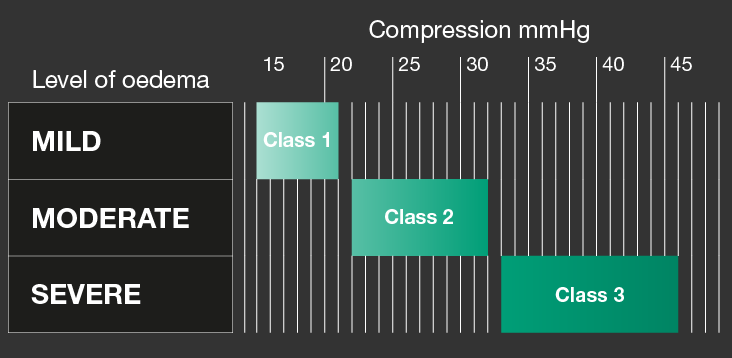An overview of compression therapy and its benefits
Posted by Jeanne Everett on 26th Feb 2020
To appreciate the benefits of compression in managing lymphoedema, it is helpful to understand how compression works and what it actually does. Understanding the importance of compression helps us to realise its role in managing lymphoedema.
Compression can come in various forms:
- Armsleeves or stockings
- Bandages
- Adjustable compression wrap systems
To make things simple, we’ll use the term “garment” to refer to any or all of the above.
How Does Compression Work?
1. Compression Classes

The term “compression” refers to the amount of pressure exerted on the skin. This pressure is measured in “millimetres of mercury”, a scientific unit abbreviated as “mmHg”. Obviously, the higher the pressure, the greater the force exerted on the skin by the garment. So, for example, a garment giving a compression of 15-21 mmHg is exerting a much lower compression than one giving a compression of 34-48 mmHg.
In
managing lymphoedema, we always try to use the highest compression that we
safely can, once we have taken account of any contraindications. However, the choice of compression class we are going
to use will depend not only on the severity of the lymphoedema, but also on how
easy it is to put the garment on and take it off, and whether the skin is in
good condition; the skin should be strong and healthy enough to be able to
tolerate putting on a compression garment.
2. Graduated Compression

Lymphoedema
garments are made so that the compression they exert is “graduated”. This means
that more pressure is exerted at the bottom of the garment than at the top. The
effect of having greater compression at the wrist or ankle, and less where the
garment ends (the top of the arm, below the knee, or the top of the thigh), is
to move fluid up the limb instead of it being pushed downwards towards the
hands or the feet. By encouraging this “upward” movement towards draining lymph
nodes, wearing a compression garment helps to reduce the amount of fluid in the
arm or the leg.
3. Preventing Fluid from Accumulating in the Tissues
By wearing a compression garment less fluid is able to seep out of the arteries and “sit” in the tissue spaces, which is what happens when you have lymphoedema. Lymphoedema garments help to limit this formation of tissue fluid. Because the limb is supported by the garment, fluid from the tissues moves more easily into the lymphatic drainage vessels. The constant pressure being exerted on the skin by the garment means that less fluid stays in the tissues and more drains away, which helps to reduce the swelling.
4. Improving Lymph Drainage
Compression improves lymph drainage in two important ways:
- Firstly, because tissue fluid is immobile or “stagnant”, compression is needed to mobilize the fluid in the tissues and move it into the lymphatic system. Garments help to then propel the lymph fluid towards normally functioning lymph vessels and so improve lymphatic drainage.
- Secondly, exercise and movement whilst wearing a compression garment causes changes in pressure in the tissues, and this also improves lymph drainage.
5. Reduction in Pain and Discomfort
One of the important benefits of wearing a compression
garment is that it supports swollen tissues and thus helps to alleviate pain,
heaviness, and aching. So long as the garment has been properly
measured and is a correct fit, the comfort it gives to a heavy, swollen limb
will be a very positive outcome.
6. Improved Shape and Appearance of the Limb
The general shape of a swollen limb is improved when contained within a compression garment. To illustrate this, the following are some comments from those wearing Haddenham garments (available through lymphshop), both sleeves and stockings:
“The sleeve was elegant.”
“Lace effect (grip top) felt more feminine.”
“My arm feels safe & secure.”
“Aesthetically pleasing – especially due to different colours available.”
“I feel secure, knowing the stockings keep the lymphoedema controlled even if I’m ‘on my feet’ all day.”
Lastly, it should be noted that it is important to persevere with wearing the prescribed garment, since compression is also key in reducing the risk of complications which may develop with lymphoedema. Any compression garment must therefore be fit-for-purpose, well-fitting, comfortable and aesthetically pleasing. The wide range and choice of garments available from Haddenham Healthcare means that this is an achievable outcome for those needing to wear compression garments.
About the author
Jeanne started her lymphoedema career in the early 1990s, setting up the lymphoedema clinic in Durham. She then moved into a specialist clinical role across South Durham, Teesside and North Yorkshire, and in 2013 set up the Lymphoedema Service based in Imperial Healthcare Trust at Charing Cross Hospital. Jeanne is now the Lymphoedema Nurse at St Teresa’s Hospice in Darlington, where her passion for education continues.